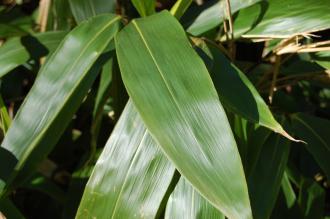
Indocalamus tessellatus (01/03/2015, Kew Gardens, London)
Position: Full sun to partial shade
Flowering period: N/A
Soil: Moist, well drained
Eventual Height: 2m
Eventual Spread: 2.5m
Hardiness: 6a, 6b, 7a, 7b, 8a, 8b, 9a, 9b
Family: Poaceae
Indocalamus tessellatus is an evergreen running bamboo with a clump forming habit. Its mid green leaves are linear with entire margins, up to 45cm long and 10cm broad. Its canes may achieve a diameter of up to 15mm. Its roots are rhizome which enables its spread.
Indocalamus tessellatus, commonly known as Giant Leaf Bamboo, is native to east China. In its native habitat it grows in open forests. Indocalamus tessellatus is synonymous with Sasa tessellata.
The etymological root of the binomial name Indocalamus is derived from the Latin Indus meaning ‘India’ and kalamos meaning ‘reed’. Tessellatus is from the Latin meaning ‘mosaic’.
The landscape architect may find Indocalamus tessellatus useful as an evergreen screening bamboo with a tropical appearance. It may be used for erosion control along flood plains.

Indocalamus tessellatus Leaf (01/03/2015, Kew Gardens, London)
Ecologically, Indocalamus tessellatus is of little UK value.
The Royal Horticultural Society has given Indocalamus tessellatus their prestigious Award of Garden Merit in 2002.
Indocalamus tessellatus prefers moist, humus rich, well-drained soils. It tolerates most pH of soil. It will tolerate wet soils.
Indocalamus tessellatus requires little maintenance. A root barrier could be install at the time of panting to prevent its over vigorous spread.

